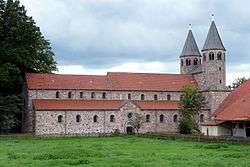Convent
A convent is either a community of priests, religious brothers, religious sisters, monks or nuns; or the building used by the community, particularly in the Catholic Church, Lutheran churches, and the Anglican Communion.[1]
.jpg)
Etymology and usage
The term derives via Old French from Latin conventus, perfect participle of the verb convenio, meaning to convene, to come together. The original reference was to the gathering of mendicants who spent much of their time travelling. Technically, a “monastery" or "nunnery" is a community of monastics, whereas a "friary" or "convent" is a community of mendicants, and a "canonry" a community of canons regular. The terms “abbey" and “priory" can be applied to both monasteries and canonries; an abbey is headed by an Abbot, and a priory is a lesser dependent house headed by a Prior.
In English usage since about the 19th century the term "convent" almost invariably refers to a community of women,[2] while "monastery" and "friary" are used for men. In historical usage they are often interchangeable, with "convent" especially likely to be used for a friary. When applied to religious houses in Eastern Orthodoxy and Buddhism, English refers to all houses of male religious as "monasteries" and of female religious "convents".
Gallery
- Convent of the Conceptionists in Ágreda founded by Mary of Jesus of Ágreda (where her body is said to rest, incorrupt)
 Bursfelde Abbey has continued as a Lutheran convent since A.D. 1579
Bursfelde Abbey has continued as a Lutheran convent since A.D. 1579
References
- Evangelisti, Silvia (2008). Nuns: A History of Convent Life, 1450-1700. Oxford University Press. p. 38-39. ISBN 9780199532056.
Finally, irrespective of religious beliefs, convents remained a possible model for women--Catholic as well as Protestant--to pursue. In Protestant Germany, forms of female religious associative life did not die out, but instead survived in the shape of Protestant convents. These could be governed by a Lutheran abbess, and inhabited by Lutheran nuns in religious habits who claimed membership of a monastic order, paradoxical though this may seem.
- See Etym on line
External links
| Wikimedia Commons has media related to Convents. |
- Herbermann, Charles, ed. (1913). . Catholic Encyclopedia. New York: Robert Appleton Company.
- Carmelite Monastery of the Sacred Hearts —- an example of a modern-day convent
- Chisholm, Hugh, ed. (1911). . Encyclopædia Britannica (11th ed.). Cambridge University Press.
